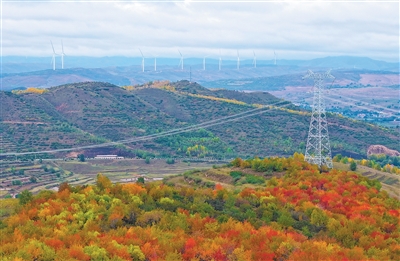




- BRNN
- BRI News
- BRNN News
- Database
Official Documents Polices and Regulations
Inter-government Documents International Cooperation BRI Countries
Business Guide Economic Data BRI Data
Trade
Investment Projects Latest projects
Cases - Content Pool

Photo shows a section of the Ningxia-Hunan ±800 kV ultra-high-voltage (UHV) direct current transmission project, which brings electricity from northwest China's Ningxia Hui Autonomous Region to central China's Hunan Province. (Photo/Yuan Hongyan)
During the 14th Five-Year Plan period (2021-2025), China's ultra-high-voltage (UHV) alternating current (AC) and direct current (DC) transmission projects have made steady progress. To date, 45 UHV projects are in operation in the country.
By year's end, the transmission capacity of the country's west-to-east power transmission program is expected to reach more than 340 million kilowatts, representing a 25 percent increase from 270 million kilowatts at the end of the 13th Five-Year Plan period (2016-2020).
The ±800 kV UHV DC transmission project, which spans from Baihetan in southwest China to east China's Jiangsu Province, serves as a key component of the country's west-to-east power transmission program. Stretching 2,080 kilometers across provincial-level regions including Sichuan, Chongqing, Hubei, Anhui and Jiangsu, this UHV DC project delivers hydropower from Baihetan to Jiangsu in just 7 milliseconds.

Photo shows workers carrying out conductor stringing tasks for the Gansu-Zhejiang ±800 kV ultra-high-voltage (UHV) direct current transmission project in Nanling county, Wuhu, east China's Anhui Province. (Photo/Zheng Xianlie)
During the 14th Five-Year Plan period, China has accelerated the construction of interprovincial and cross-regional UHV DC transmission corridors. According to an executive of the UHV division of State Grid Corporation of China (SGCC), the company has launched eight UHV DC projects over the past nearly five years, including the Baihetan-Jiangsu project. These projects span 13,600 kilometers and ensure more than 50 million kilowatts of cross-regional UHV DC transmission capacity.
Data from the National Energy Administration (NEA) shows that during the 14th Five-Year Plan period, the length of China's UHV DC transmission lines has increased from 28,000 kilometers to more than 40,000 kilometers. China has now built one ±1,100 kV UHV line, 23 ±800 kV UHV lines, and 21 1,000 kV UHV lines, forming the world's largest and most technologically advanced ultra-long-distance power transmission network.
The NEA official noted that during the period, China's regional power grid structure has been significantly optimized. Building on the UHV main grids established in north China and east China during the 13th Five-Year Plan period, four provinces in central China and the Sichuan-Chongqing region have also established UHV AC main grids during the 14th Five-Year Plan period.
China's first "wind-solar-thermal-storage integration" project entered operation in May with the launch of the Longdong-Shandong ±800 kV UHV DC transmission project.

Photo shows a worker replacing composite insulators for a 1,000 kV transmission line in Huaian, east China's Jiangsu Province. (Photo/Shi Jun)
Designed to deliver 36 billion kilowatt-hours of electricity annually, the project stretches 915 kilometers from Qingyang in northwest China's Gansu Province to Tai'an in east China's Shandong Province. More than half of the electricity transmitted by the line comes from clean sources.
The Ningxia-Hunan ±800 kV UHV DC transmission project, which transmits electricity from northwest China's Ningxia Hui Autonomous Region to central China's Hunan Province, was put into operation in October 2025. It is a UHV transmission project specifically designed to deliver power from large wind and photovoltaic bases located in sandy areas, rocky regions and deserts. The project is expected to transmit more than 36 billion kilowatt-hours of electricity to Hunan each year, with at least 50 percent of the power coming from renewable energy sources.
In 2024, cross-regional UHV DC channels transmitted approximately 420 billion kilowatt-hours of clean energy, a 70 percent rise from the end of the 13th Five-Year Plan period, accounting for nearly 60 percent of total transmitted power, according to the NEA official.
As the first UHV AC project in southwest China, SGCC's Sichuan–Chongqing 1,000 kV UHV AC project has achieved 26 "world firsts."
This represents just one example of China's remarkable technological innovation in UHV projects. The NEA official explained that UHV grid technology has achieved innovative breakthroughs and engineering applications in topology, flexible transmission and high-altitude construction during the 14th Five-Year Plan period. These advances meet the requirements for large-scale new energy transmission and ensure the safe and stable operation of multi-infeed DC grids.
SGCC has developed standardized technology for UHV DC transmission at ±800 kV and 8 million kilowatts, covering design, equipment, construction, commissioning and management, according to the executive of the company's UHV division. It has also developed more than 500 standardized technical documents, enhancing the industry chain of power transmission and transformation equipment.
During the 14th Five-Year Plan period, several technological bottlenecks for UHV have been resolved, according to the executive of the UHV division of SGCC.
The Longdong-Shandong ±800 kV UHV DC transmission project, for example, was the first to apply domestically produced tap changers and DC control and protection systems based on independently developed chips.
The Zhangbei flexible DC power grid project in Zhangjiakou, north China's Hebei Province, deployed domestically produced DC dry capacitors, breaking foreign monopolies on core equipment and upgrading the technical level and manufacturing capacity of China's electrical equipment enterprises.
These advances are helping China move from a "big manufacturer" to a "strong manufacturer" in power equipment, the executive said.

Tel:86-10-65363107, 86-10-65368220, 86-10-65363106